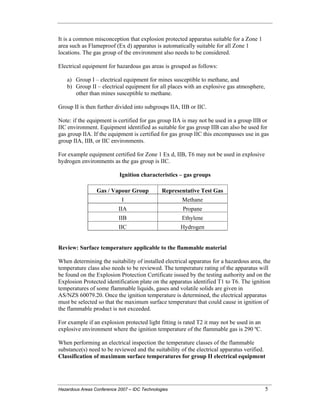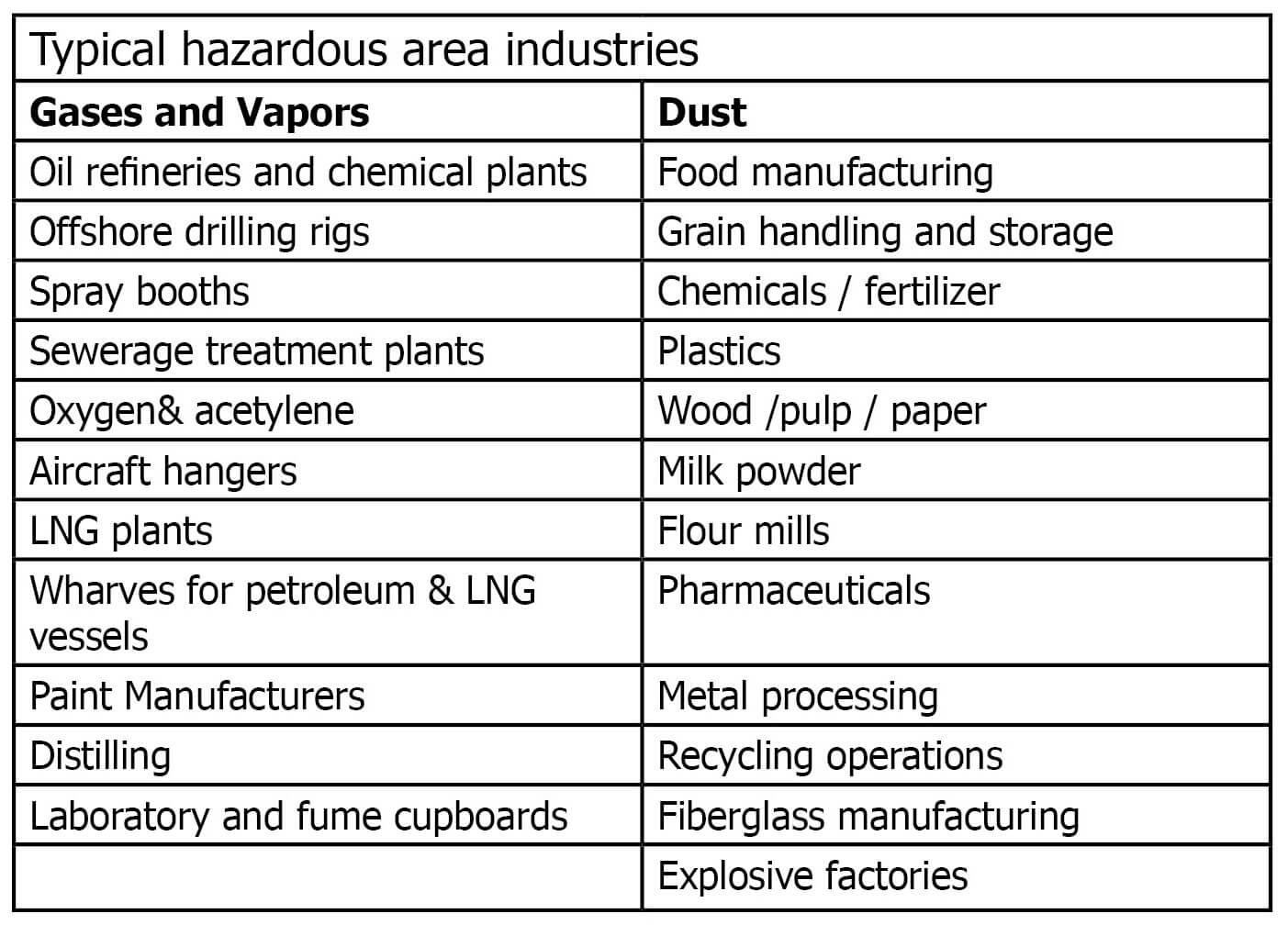The Buzz on Roar Solutions
The Buzz on Roar Solutions
Blog Article
The 8-Minute Rule for Roar Solutions
Table of ContentsRoar Solutions for BeginnersFascination About Roar Solutions4 Easy Facts About Roar Solutions Described
In order to protect setups from a prospective surge a method of evaluating and identifying a potentially dangerous area is called for. The objective of this is to guarantee the right option and installation of tools to ultimately protect against a surge and to guarantee safety of life.
(https://my.omsystem.com/members/roarsolutions)
No tools ought to be set up where the surface area temperature level of the tools is higher than the ignition temperature of the provided hazard. Below are some common dust dangerous and their minimal ignition temperature. Coal Dust 380C 225C Polythene 420C (thaws) Methyl Cellulose 420C 320C Starch 460C 435C Flour 490C 340C Sugar 490C 460C Grain Dust 510C 300C Phenolic Resin 530C > 450C Aluminium 590C > 450C PVC 700C > 450C Soot 810C 570C The probability of the risk existing in a focus high sufficient to trigger an ignition will differ from place to place.
In order to classify this risk an installation is separated right into locations of threat depending upon the quantity of time the hazardous is present. These locations are described as Zones. For gases and vapours and dirts and fibers there are 3 areas. Area 0 Area 20 An unsafe ambience is very most likely to be existing and might exist for long durations of time (> 1000 hours per year) or perhaps continuously Zone 1 Zone 21 A dangerous atmosphere is possible however unlikely to be existing for lengthy periods of time (> 10 450 C [842 F] A category of T6 indicates the minimum ignition temperature level is > 85 C [185 F] Dangerous area electrical tools maybe designed for use in higher ambient temperature levels. This would certainly suggested on the rating plate e.g. EExe II C T3 Ta + 60C( This means at 60C ambient T3 will not be exceeded) T1 T1, T2, T3, T4, T5, T6 T2 T2, T3, T4, T5, T6 T3 T3, T4, T5, T6 T4 T4, T5, T6 T5 T5, T6 T6 T6 A T Course ranking of T1 means the optimum surface temperature level created by the instrument at 40 C is 450 C. Thinking the connected T Class and Temperature level ranking for the equipment are proper for the area, you can constantly use an instrument with an extra rigorous Division score than needed for the area. There isn't a clear solution to this inquiry sadly. It really does rely on the sort of devices and what repairs require to be performed. Devices with details examination treatments that can't be executed in the field in order to achieve/maintain 3rd party rating. Must return to the manufacturing facility if it is prior to the equipment's solution. Field Repair Service By Authorised Worker: Difficult testing might not be needed however certain procedures might need to be followed in order for the devices to keep its third event score. Authorized personnel must be employed to do the job appropriately Repair service must be a like for like substitute. New part must be thought about as a direct substitute requiring no unique screening of the equipment after the repair is total. Each piece of devices with an unsafe score must be reviewed individually. These are detailed at a high level listed below, but also for more detailed details, please refer straight to the guidelines.
The Buzz on Roar Solutions
The tools register is a thorough data source of equipment documents that includes a minimum set of areas to determine each item's place, technological specifications, Ex category, age, and ecological data. This info is crucial for tracking and taking care of the tools properly within harmful locations. In comparison, for routine or RBI tasting inspections, the grade will certainly be a mix of Thorough and Close inspections. The ratio of In-depth to Close assessments will be figured out by the Tools Threat, which is examined based upon ignition risk (the probability of a source of ignition versus the probability of a flammable ambience )and the harmful area classification
( Zone 0, 1, or 2). This variant will also influence the resourcing demands for work preparation. Once Great deals are specified, you can develop sampling plans based on the example size of each Lot, which describes the variety of random tools items to be examined. To figure out the needed example size, two facets require to be assessed: the size of the Whole lot and the group of evaluation, which suggests the level of effort that must be applied( lowered, typical, or boosted )to the evaluation of the Lot. By incorporating the group of examination with the Great deal dimension, you can after that develop the appropriate being rejected standards for an example, suggesting the allowable number of malfunctioning products found within that example. For more details on this process, please describe the Energy Institute Standards. The IEC 60079 standard recommends that the maximum interval in between evaluations need to not exceed 3 years. EEHA inspections will certainly also be performed beyond RBI projects as component of arranged maintenance and tools overhauls or repairs. These inspections can be credited toward the RBI sample dimensions within the influenced Whole lots. EEHA evaluations are conducted to determine mistakes in electric equipment. A heavy scoring system is essential, as a single piece of devices might have multiple faults, each with varying degrees of ignition threat. If the mixed rating of both inspections is less than two times the fault rating, the Great deal is considered acceptable. If the Whole lot is still thought about inappropriate, it needs to go through a complete assessment or justification, which might set off stricter examination procedures. Accepted Great deal: The root causes of any faults are determined. If a common failure setting is discovered, additional tools may need maintenance. Faults are categorized by severity( Safety and security, Integrity, House cleaning ), making sure that urgent problems are examined and resolved without delay to minimize any effect on security or operations. The EEHA database should track and tape-record the lifecycle of faults along with the restorative activities taken. Implementing a durable Risk-Based Evaluation( RBI )strategy is important for ensuring conformity and safety in taking care of Electrical Tools in Hazardous Areas( EEHA) (eeha training). Automated Fault Rating and Lifecycle Monitoring: Easily take care of faults and track their lifecycle to improve assessment precision. The intro of this assistance for risk-based inspection better strengthens Inspectivity's setting as a best-in-class solution for regulative conformity, in addition to for any asset-centric inspection use case. If you have an interest in finding out more, we invite you to request a presentation and uncover just how our solution can transform your EEHA monitoring procedures.
The 9-Minute Rule for Roar Solutions

In terms of explosive risk, a dangerous location is an environment in which an eruptive ambience is present (or may be anticipated to be present) in quantities that require special precautions for the construction, installment and use tools. high voltage courses. In this write-up we explore the challenges dealt with in the workplace, the risk control actions, and the needed competencies to work securely
It is an effect of contemporary life that we produce, store or manage a variety of gases or fluids that are regarded combustible, and a variety of dusts that are deemed flammable. These compounds can, in certain conditions, create eruptive ambiences and these can have major and unfortunate effects. A lot of us are familiar with the fire triangular eliminate any one of the 3 aspects and the fire can not occur, but what does this mean in the context of unsafe areas? When breaking this down right into its simplest terms it is basically: a combination of a particular amount of launch or leakage of a particular compound or product, combining with ambient oxygen, and the existence of a resource of ignition.
In most instances, we can do little about the levels of oxygen in the air, yet we can have significant visit this website influence on resources of ignition, as an example electric equipment. Dangerous areas are documented on the harmful location category drawing and are recognized on-site by the triangular "EX-SPOUSE" indication. Right here, amongst other essential information, zones are split right into 3 types depending upon the danger, the probability and duration that an explosive ambience will certainly exist; Zone 0 or 20 is considered the most unsafe and Zone 2 or 22 is considered the least.
Report this page